Business Law Report: Parliament, UK Law, Business Types, and Disputes
VerifiedAdded on 2020/10/05
|14
|4242
|90
Report
AI Summary
This business law report provides a comprehensive overview of key legal concepts relevant to businesses in the UK. It begins by examining the concept of parliamentary sovereignty and the various sources of UK law, including common law, legislation, and European Union law. The report then delves into the role of government in lawmaking and the application of statutory and common law within the justice system. A significant portion of the report is dedicated to exploring the impact of company law, contract law, and employment law on business operations. The report further analyzes different business formations, differentiating between sole proprietorships, partnerships, limited liability companies, and corporations, along with their respective advantages and disadvantages, including a comparison of incorporated and unincorporated businesses. The report also includes case studies to solve business law disputes with legal solutions. The report concludes by comparing the advantages and disadvantages of a company over a partnership. The report is designed to assist students in understanding the complexities of business law and its practical implications.
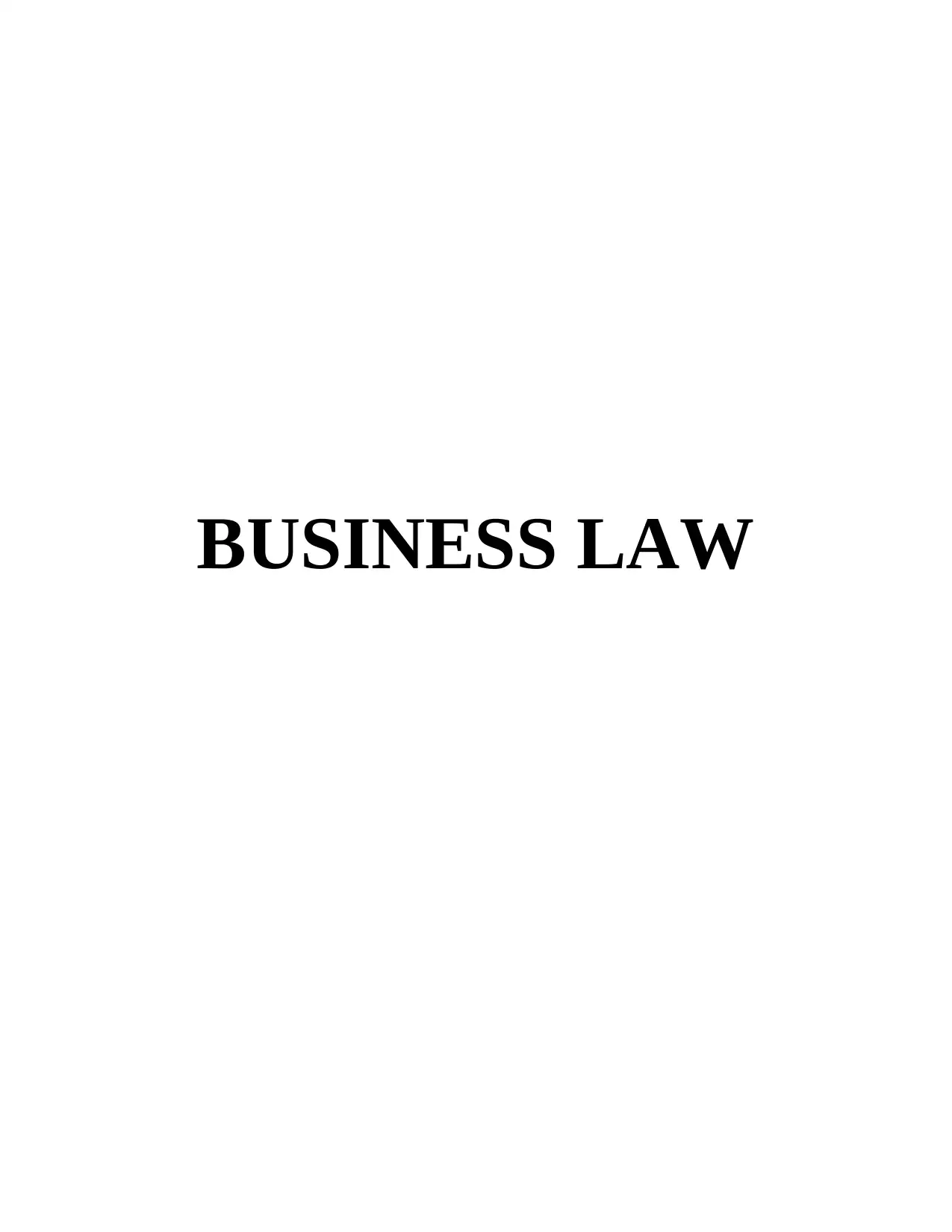
BUSINESS LAW
Paraphrase This Document
Need a fresh take? Get an instant paraphrase of this document with our AI Paraphraser
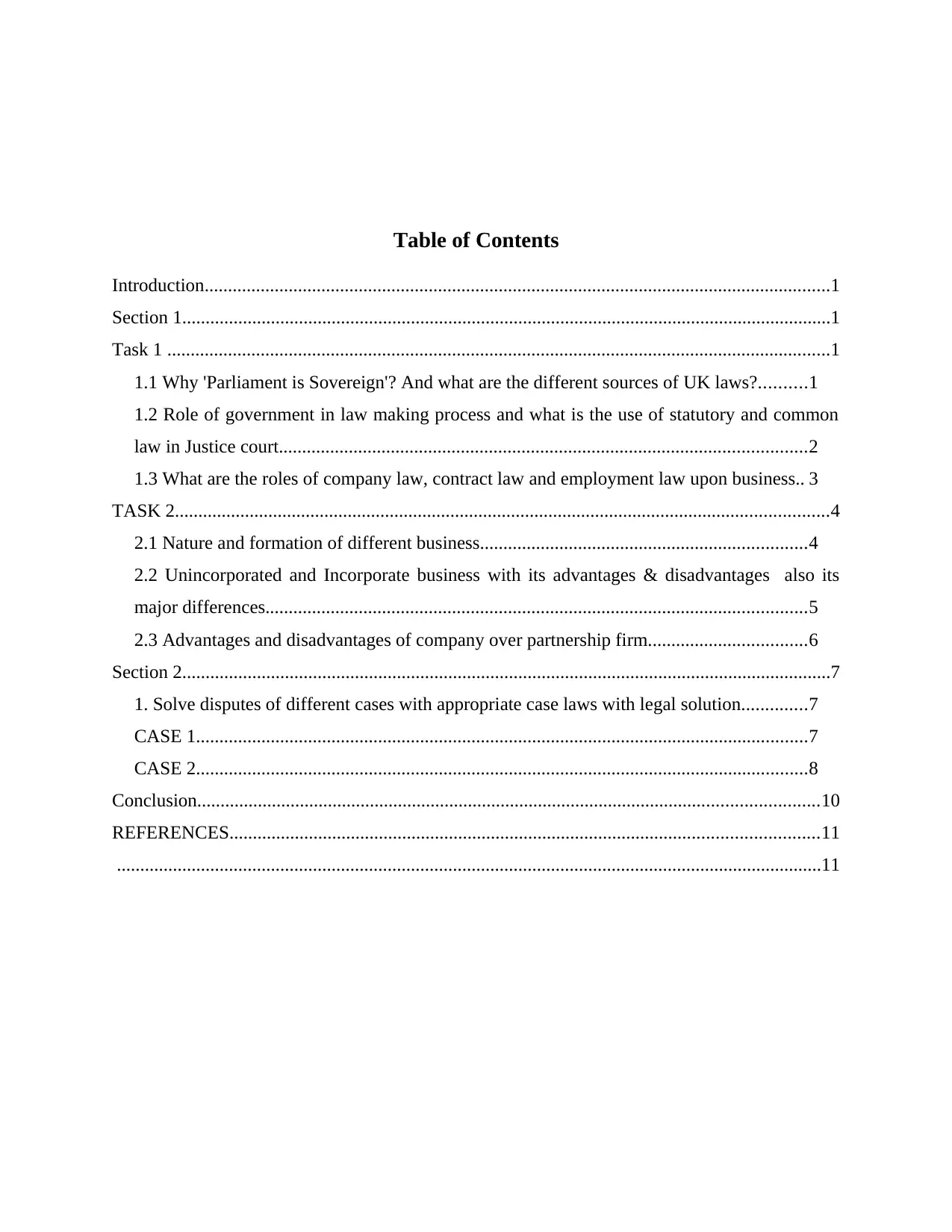
Table of Contents
Introduction......................................................................................................................................1
Section 1...........................................................................................................................................1
Task 1 ..............................................................................................................................................1
1.1 Why 'Parliament is Sovereign'? And what are the different sources of UK laws?..........1
1.2 Role of government in law making process and what is the use of statutory and common
law in Justice court.................................................................................................................2
1.3 What are the roles of company law, contract law and employment law upon business.. 3
TASK 2............................................................................................................................................4
2.1 Nature and formation of different business......................................................................4
2.2 Unincorporated and Incorporate business with its advantages & disadvantages also its
major differences....................................................................................................................5
2.3 Advantages and disadvantages of company over partnership firm..................................6
Section 2...........................................................................................................................................7
1. Solve disputes of different cases with appropriate case laws with legal solution..............7
CASE 1...................................................................................................................................7
CASE 2...................................................................................................................................8
Conclusion.....................................................................................................................................10
REFERENCES..............................................................................................................................11
.......................................................................................................................................................11
Introduction......................................................................................................................................1
Section 1...........................................................................................................................................1
Task 1 ..............................................................................................................................................1
1.1 Why 'Parliament is Sovereign'? And what are the different sources of UK laws?..........1
1.2 Role of government in law making process and what is the use of statutory and common
law in Justice court.................................................................................................................2
1.3 What are the roles of company law, contract law and employment law upon business.. 3
TASK 2............................................................................................................................................4
2.1 Nature and formation of different business......................................................................4
2.2 Unincorporated and Incorporate business with its advantages & disadvantages also its
major differences....................................................................................................................5
2.3 Advantages and disadvantages of company over partnership firm..................................6
Section 2...........................................................................................................................................7
1. Solve disputes of different cases with appropriate case laws with legal solution..............7
CASE 1...................................................................................................................................7
CASE 2...................................................................................................................................8
Conclusion.....................................................................................................................................10
REFERENCES..............................................................................................................................11
.......................................................................................................................................................11

⊘ This is a preview!⊘
Do you want full access?
Subscribe today to unlock all pages.

Trusted by 1+ million students worldwide
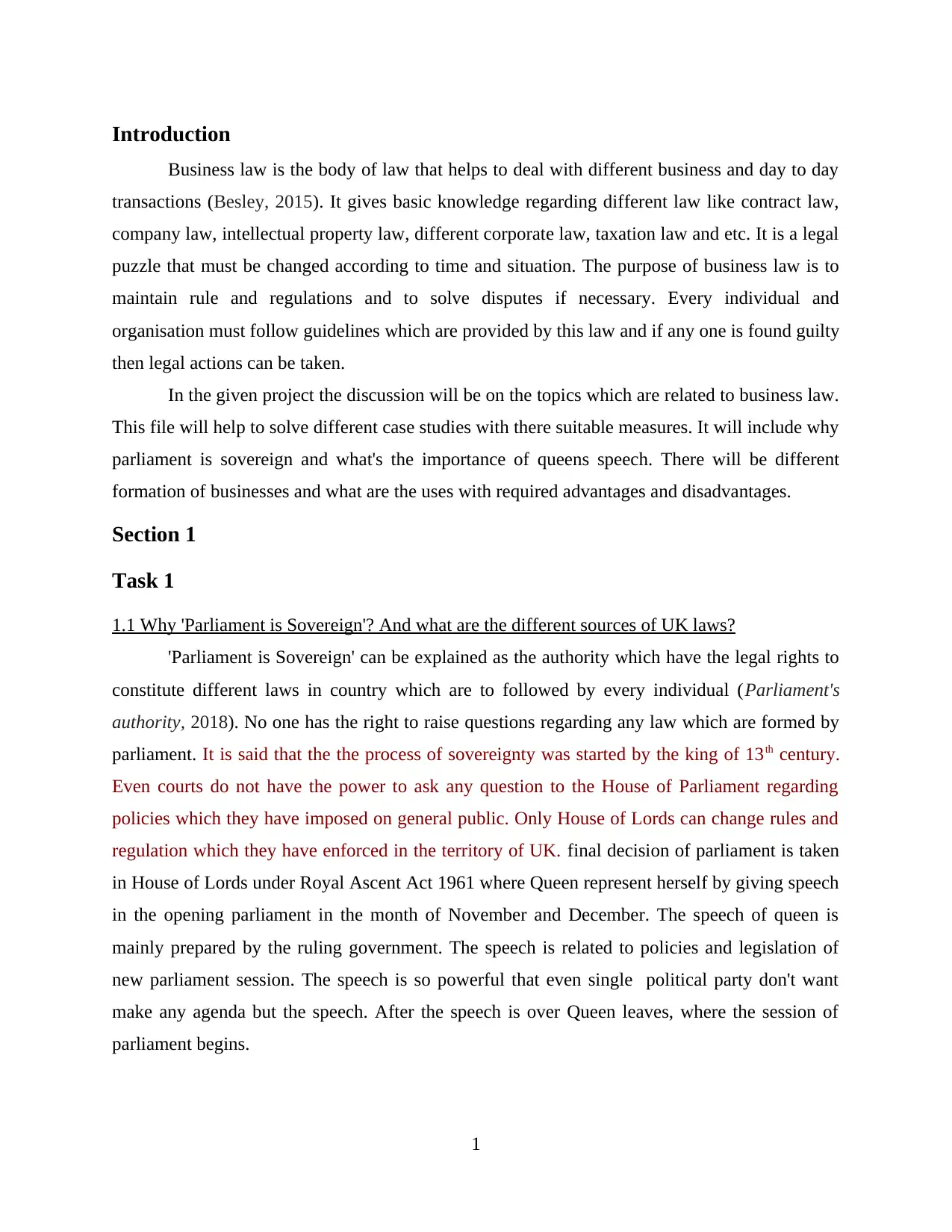
Introduction
Business law is the body of law that helps to deal with different business and day to day
transactions (Besley, 2015). It gives basic knowledge regarding different law like contract law,
company law, intellectual property law, different corporate law, taxation law and etc. It is a legal
puzzle that must be changed according to time and situation. The purpose of business law is to
maintain rule and regulations and to solve disputes if necessary. Every individual and
organisation must follow guidelines which are provided by this law and if any one is found guilty
then legal actions can be taken.
In the given project the discussion will be on the topics which are related to business law.
This file will help to solve different case studies with there suitable measures. It will include why
parliament is sovereign and what's the importance of queens speech. There will be different
formation of businesses and what are the uses with required advantages and disadvantages.
Section 1
Task 1
1.1 Why 'Parliament is Sovereign'? And what are the different sources of UK laws?
'Parliament is Sovereign' can be explained as the authority which have the legal rights to
constitute different laws in country which are to followed by every individual (Parliament's
authority, 2018). No one has the right to raise questions regarding any law which are formed by
parliament. It is said that the the process of sovereignty was started by the king of 13th century.
Even courts do not have the power to ask any question to the House of Parliament regarding
policies which they have imposed on general public. Only House of Lords can change rules and
regulation which they have enforced in the territory of UK. final decision of parliament is taken
in House of Lords under Royal Ascent Act 1961 where Queen represent herself by giving speech
in the opening parliament in the month of November and December. The speech of queen is
mainly prepared by the ruling government. The speech is related to policies and legislation of
new parliament session. The speech is so powerful that even single political party don't want
make any agenda but the speech. After the speech is over Queen leaves, where the session of
parliament begins.
1
Business law is the body of law that helps to deal with different business and day to day
transactions (Besley, 2015). It gives basic knowledge regarding different law like contract law,
company law, intellectual property law, different corporate law, taxation law and etc. It is a legal
puzzle that must be changed according to time and situation. The purpose of business law is to
maintain rule and regulations and to solve disputes if necessary. Every individual and
organisation must follow guidelines which are provided by this law and if any one is found guilty
then legal actions can be taken.
In the given project the discussion will be on the topics which are related to business law.
This file will help to solve different case studies with there suitable measures. It will include why
parliament is sovereign and what's the importance of queens speech. There will be different
formation of businesses and what are the uses with required advantages and disadvantages.
Section 1
Task 1
1.1 Why 'Parliament is Sovereign'? And what are the different sources of UK laws?
'Parliament is Sovereign' can be explained as the authority which have the legal rights to
constitute different laws in country which are to followed by every individual (Parliament's
authority, 2018). No one has the right to raise questions regarding any law which are formed by
parliament. It is said that the the process of sovereignty was started by the king of 13th century.
Even courts do not have the power to ask any question to the House of Parliament regarding
policies which they have imposed on general public. Only House of Lords can change rules and
regulation which they have enforced in the territory of UK. final decision of parliament is taken
in House of Lords under Royal Ascent Act 1961 where Queen represent herself by giving speech
in the opening parliament in the month of November and December. The speech of queen is
mainly prepared by the ruling government. The speech is related to policies and legislation of
new parliament session. The speech is so powerful that even single political party don't want
make any agenda but the speech. After the speech is over Queen leaves, where the session of
parliament begins.
1
Paraphrase This Document
Need a fresh take? Get an instant paraphrase of this document with our AI Paraphraser
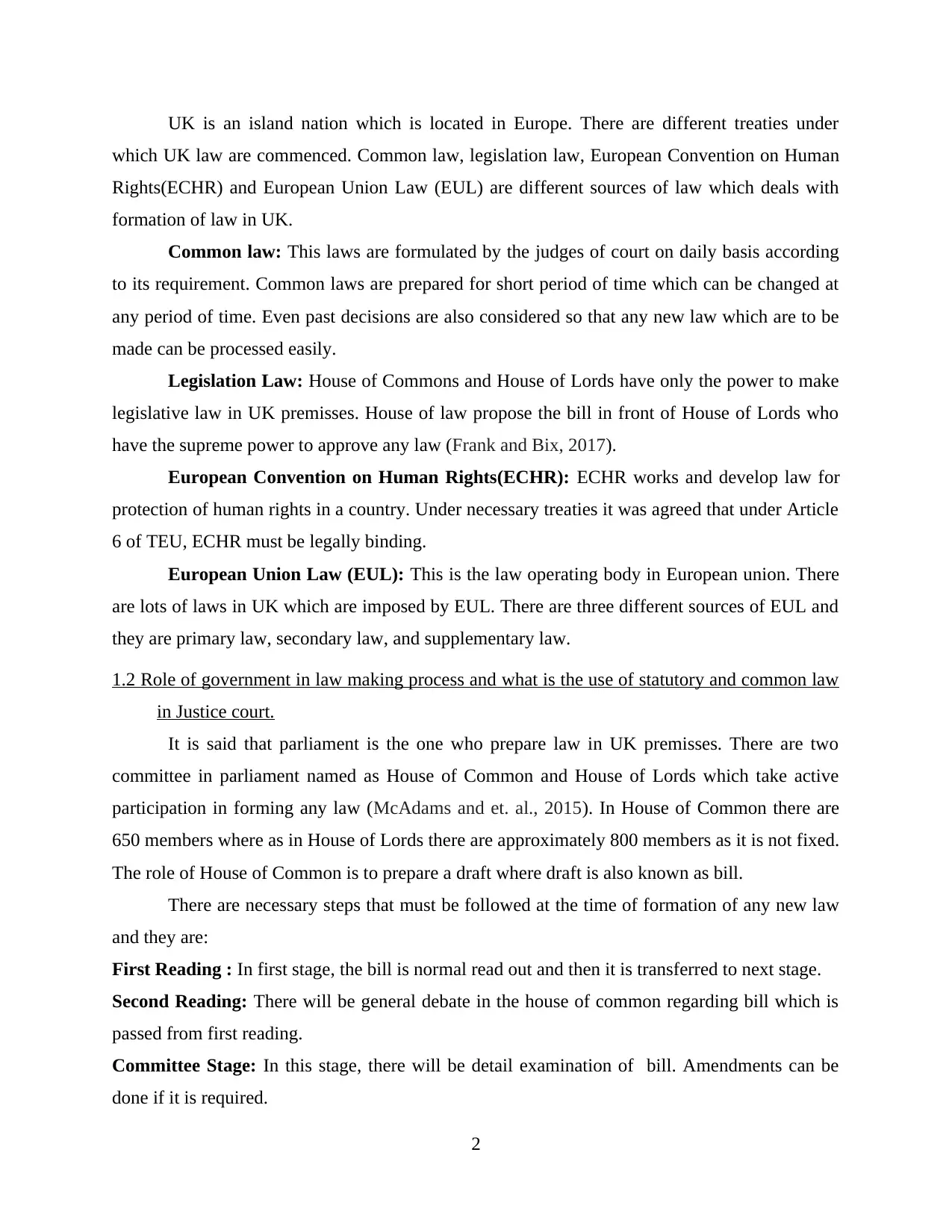
UK is an island nation which is located in Europe. There are different treaties under
which UK law are commenced. Common law, legislation law, European Convention on Human
Rights(ECHR) and European Union Law (EUL) are different sources of law which deals with
formation of law in UK.
Common law: This laws are formulated by the judges of court on daily basis according
to its requirement. Common laws are prepared for short period of time which can be changed at
any period of time. Even past decisions are also considered so that any new law which are to be
made can be processed easily.
Legislation Law: House of Commons and House of Lords have only the power to make
legislative law in UK premisses. House of law propose the bill in front of House of Lords who
have the supreme power to approve any law (Frank and Bix, 2017).
European Convention on Human Rights(ECHR): ECHR works and develop law for
protection of human rights in a country. Under necessary treaties it was agreed that under Article
6 of TEU, ECHR must be legally binding.
European Union Law (EUL): This is the law operating body in European union. There
are lots of laws in UK which are imposed by EUL. There are three different sources of EUL and
they are primary law, secondary law, and supplementary law.
1.2 Role of government in law making process and what is the use of statutory and common law
in Justice court.
It is said that parliament is the one who prepare law in UK premisses. There are two
committee in parliament named as House of Common and House of Lords which take active
participation in forming any law (McAdams and et. al., 2015). In House of Common there are
650 members where as in House of Lords there are approximately 800 members as it is not fixed.
The role of House of Common is to prepare a draft where draft is also known as bill.
There are necessary steps that must be followed at the time of formation of any new law
and they are:
First Reading : In first stage, the bill is normal read out and then it is transferred to next stage.
Second Reading: There will be general debate in the house of common regarding bill which is
passed from first reading.
Committee Stage: In this stage, there will be detail examination of bill. Amendments can be
done if it is required.
2
which UK law are commenced. Common law, legislation law, European Convention on Human
Rights(ECHR) and European Union Law (EUL) are different sources of law which deals with
formation of law in UK.
Common law: This laws are formulated by the judges of court on daily basis according
to its requirement. Common laws are prepared for short period of time which can be changed at
any period of time. Even past decisions are also considered so that any new law which are to be
made can be processed easily.
Legislation Law: House of Commons and House of Lords have only the power to make
legislative law in UK premisses. House of law propose the bill in front of House of Lords who
have the supreme power to approve any law (Frank and Bix, 2017).
European Convention on Human Rights(ECHR): ECHR works and develop law for
protection of human rights in a country. Under necessary treaties it was agreed that under Article
6 of TEU, ECHR must be legally binding.
European Union Law (EUL): This is the law operating body in European union. There
are lots of laws in UK which are imposed by EUL. There are three different sources of EUL and
they are primary law, secondary law, and supplementary law.
1.2 Role of government in law making process and what is the use of statutory and common law
in Justice court.
It is said that parliament is the one who prepare law in UK premisses. There are two
committee in parliament named as House of Common and House of Lords which take active
participation in forming any law (McAdams and et. al., 2015). In House of Common there are
650 members where as in House of Lords there are approximately 800 members as it is not fixed.
The role of House of Common is to prepare a draft where draft is also known as bill.
There are necessary steps that must be followed at the time of formation of any new law
and they are:
First Reading : In first stage, the bill is normal read out and then it is transferred to next stage.
Second Reading: There will be general debate in the house of common regarding bill which is
passed from first reading.
Committee Stage: In this stage, there will be detail examination of bill. Amendments can be
done if it is required.
2
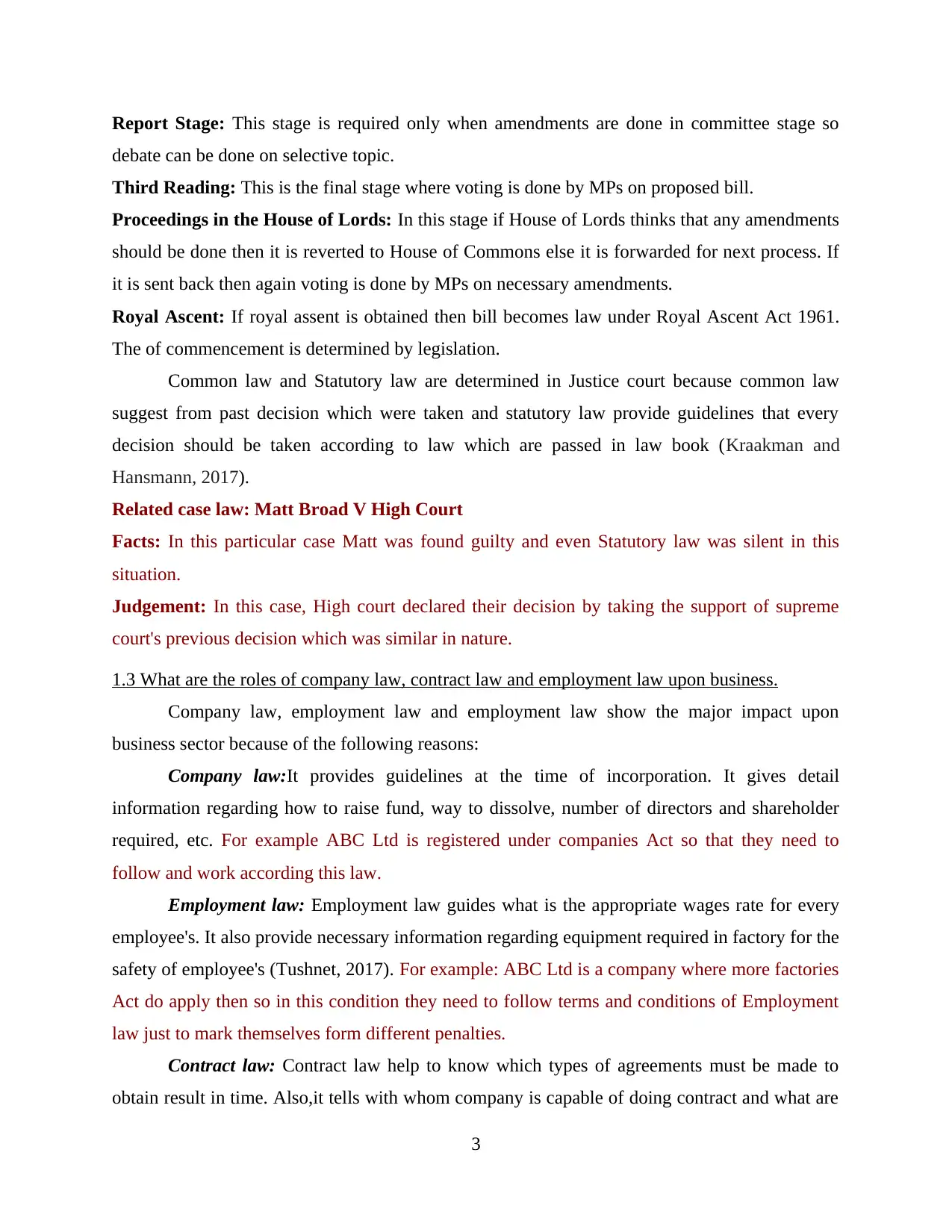
Report Stage: This stage is required only when amendments are done in committee stage so
debate can be done on selective topic.
Third Reading: This is the final stage where voting is done by MPs on proposed bill.
Proceedings in the House of Lords: In this stage if House of Lords thinks that any amendments
should be done then it is reverted to House of Commons else it is forwarded for next process. If
it is sent back then again voting is done by MPs on necessary amendments.
Royal Ascent: If royal assent is obtained then bill becomes law under Royal Ascent Act 1961.
The of commencement is determined by legislation.
Common law and Statutory law are determined in Justice court because common law
suggest from past decision which were taken and statutory law provide guidelines that every
decision should be taken according to law which are passed in law book (Kraakman and
Hansmann, 2017).
Related case law: Matt Broad V High Court
Facts: In this particular case Matt was found guilty and even Statutory law was silent in this
situation.
Judgement: In this case, High court declared their decision by taking the support of supreme
court's previous decision which was similar in nature.
1.3 What are the roles of company law, contract law and employment law upon business.
Company law, employment law and employment law show the major impact upon
business sector because of the following reasons:
Company law:It provides guidelines at the time of incorporation. It gives detail
information regarding how to raise fund, way to dissolve, number of directors and shareholder
required, etc. For example ABC Ltd is registered under companies Act so that they need to
follow and work according this law.
Employment law: Employment law guides what is the appropriate wages rate for every
employee's. It also provide necessary information regarding equipment required in factory for the
safety of employee's (Tushnet, 2017). For example: ABC Ltd is a company where more factories
Act do apply then so in this condition they need to follow terms and conditions of Employment
law just to mark themselves form different penalties.
Contract law: Contract law help to know which types of agreements must be made to
obtain result in time. Also,it tells with whom company is capable of doing contract and what are
3
debate can be done on selective topic.
Third Reading: This is the final stage where voting is done by MPs on proposed bill.
Proceedings in the House of Lords: In this stage if House of Lords thinks that any amendments
should be done then it is reverted to House of Commons else it is forwarded for next process. If
it is sent back then again voting is done by MPs on necessary amendments.
Royal Ascent: If royal assent is obtained then bill becomes law under Royal Ascent Act 1961.
The of commencement is determined by legislation.
Common law and Statutory law are determined in Justice court because common law
suggest from past decision which were taken and statutory law provide guidelines that every
decision should be taken according to law which are passed in law book (Kraakman and
Hansmann, 2017).
Related case law: Matt Broad V High Court
Facts: In this particular case Matt was found guilty and even Statutory law was silent in this
situation.
Judgement: In this case, High court declared their decision by taking the support of supreme
court's previous decision which was similar in nature.
1.3 What are the roles of company law, contract law and employment law upon business.
Company law, employment law and employment law show the major impact upon
business sector because of the following reasons:
Company law:It provides guidelines at the time of incorporation. It gives detail
information regarding how to raise fund, way to dissolve, number of directors and shareholder
required, etc. For example ABC Ltd is registered under companies Act so that they need to
follow and work according this law.
Employment law: Employment law guides what is the appropriate wages rate for every
employee's. It also provide necessary information regarding equipment required in factory for the
safety of employee's (Tushnet, 2017). For example: ABC Ltd is a company where more factories
Act do apply then so in this condition they need to follow terms and conditions of Employment
law just to mark themselves form different penalties.
Contract law: Contract law help to know which types of agreements must be made to
obtain result in time. Also,it tells with whom company is capable of doing contract and what are
3
⊘ This is a preview!⊘
Do you want full access?
Subscribe today to unlock all pages.

Trusted by 1+ million students worldwide
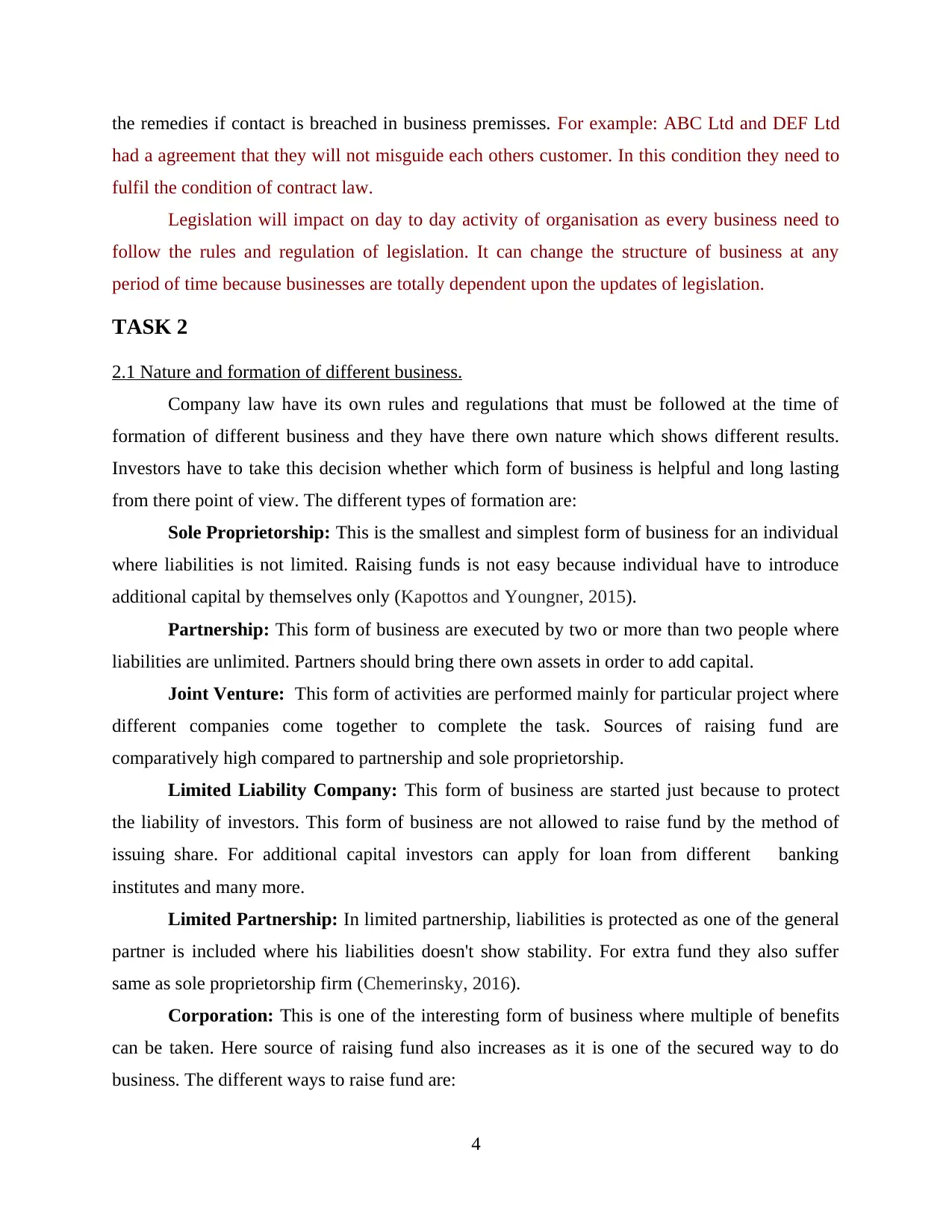
the remedies if contact is breached in business premisses. For example: ABC Ltd and DEF Ltd
had a agreement that they will not misguide each others customer. In this condition they need to
fulfil the condition of contract law.
Legislation will impact on day to day activity of organisation as every business need to
follow the rules and regulation of legislation. It can change the structure of business at any
period of time because businesses are totally dependent upon the updates of legislation.
TASK 2
2.1 Nature and formation of different business.
Company law have its own rules and regulations that must be followed at the time of
formation of different business and they have there own nature which shows different results.
Investors have to take this decision whether which form of business is helpful and long lasting
from there point of view. The different types of formation are:
Sole Proprietorship: This is the smallest and simplest form of business for an individual
where liabilities is not limited. Raising funds is not easy because individual have to introduce
additional capital by themselves only (Kapottos and Youngner, 2015).
Partnership: This form of business are executed by two or more than two people where
liabilities are unlimited. Partners should bring there own assets in order to add capital.
Joint Venture: This form of activities are performed mainly for particular project where
different companies come together to complete the task. Sources of raising fund are
comparatively high compared to partnership and sole proprietorship.
Limited Liability Company: This form of business are started just because to protect
the liability of investors. This form of business are not allowed to raise fund by the method of
issuing share. For additional capital investors can apply for loan from different banking
institutes and many more.
Limited Partnership: In limited partnership, liabilities is protected as one of the general
partner is included where his liabilities doesn't show stability. For extra fund they also suffer
same as sole proprietorship firm (Chemerinsky, 2016).
Corporation: This is one of the interesting form of business where multiple of benefits
can be taken. Here source of raising fund also increases as it is one of the secured way to do
business. The different ways to raise fund are:
4
had a agreement that they will not misguide each others customer. In this condition they need to
fulfil the condition of contract law.
Legislation will impact on day to day activity of organisation as every business need to
follow the rules and regulation of legislation. It can change the structure of business at any
period of time because businesses are totally dependent upon the updates of legislation.
TASK 2
2.1 Nature and formation of different business.
Company law have its own rules and regulations that must be followed at the time of
formation of different business and they have there own nature which shows different results.
Investors have to take this decision whether which form of business is helpful and long lasting
from there point of view. The different types of formation are:
Sole Proprietorship: This is the smallest and simplest form of business for an individual
where liabilities is not limited. Raising funds is not easy because individual have to introduce
additional capital by themselves only (Kapottos and Youngner, 2015).
Partnership: This form of business are executed by two or more than two people where
liabilities are unlimited. Partners should bring there own assets in order to add capital.
Joint Venture: This form of activities are performed mainly for particular project where
different companies come together to complete the task. Sources of raising fund are
comparatively high compared to partnership and sole proprietorship.
Limited Liability Company: This form of business are started just because to protect
the liability of investors. This form of business are not allowed to raise fund by the method of
issuing share. For additional capital investors can apply for loan from different banking
institutes and many more.
Limited Partnership: In limited partnership, liabilities is protected as one of the general
partner is included where his liabilities doesn't show stability. For extra fund they also suffer
same as sole proprietorship firm (Chemerinsky, 2016).
Corporation: This is one of the interesting form of business where multiple of benefits
can be taken. Here source of raising fund also increases as it is one of the secured way to do
business. The different ways to raise fund are:
4
Paraphrase This Document
Need a fresh take? Get an instant paraphrase of this document with our AI Paraphraser
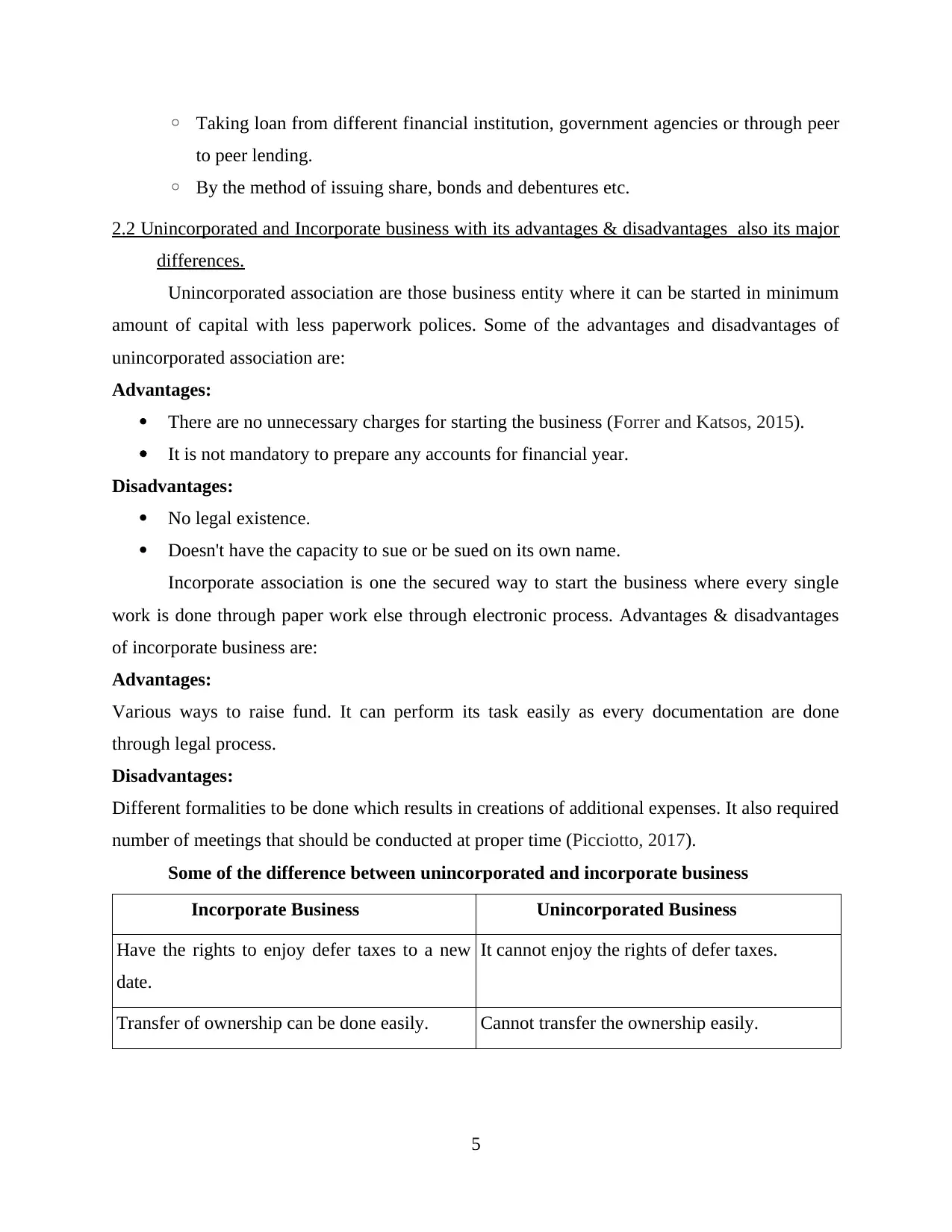
◦ Taking loan from different financial institution, government agencies or through peer
to peer lending.
◦ By the method of issuing share, bonds and debentures etc.
2.2 Unincorporated and Incorporate business with its advantages & disadvantages also its major
differences.
Unincorporated association are those business entity where it can be started in minimum
amount of capital with less paperwork polices. Some of the advantages and disadvantages of
unincorporated association are:
Advantages:
There are no unnecessary charges for starting the business (Forrer and Katsos, 2015).
It is not mandatory to prepare any accounts for financial year.
Disadvantages:
No legal existence.
Doesn't have the capacity to sue or be sued on its own name.
Incorporate association is one the secured way to start the business where every single
work is done through paper work else through electronic process. Advantages & disadvantages
of incorporate business are:
Advantages:
Various ways to raise fund. It can perform its task easily as every documentation are done
through legal process.
Disadvantages:
Different formalities to be done which results in creations of additional expenses. It also required
number of meetings that should be conducted at proper time (Picciotto, 2017).
Some of the difference between unincorporated and incorporate business
Incorporate Business Unincorporated Business
Have the rights to enjoy defer taxes to a new
date.
It cannot enjoy the rights of defer taxes.
Transfer of ownership can be done easily. Cannot transfer the ownership easily.
5
to peer lending.
◦ By the method of issuing share, bonds and debentures etc.
2.2 Unincorporated and Incorporate business with its advantages & disadvantages also its major
differences.
Unincorporated association are those business entity where it can be started in minimum
amount of capital with less paperwork polices. Some of the advantages and disadvantages of
unincorporated association are:
Advantages:
There are no unnecessary charges for starting the business (Forrer and Katsos, 2015).
It is not mandatory to prepare any accounts for financial year.
Disadvantages:
No legal existence.
Doesn't have the capacity to sue or be sued on its own name.
Incorporate association is one the secured way to start the business where every single
work is done through paper work else through electronic process. Advantages & disadvantages
of incorporate business are:
Advantages:
Various ways to raise fund. It can perform its task easily as every documentation are done
through legal process.
Disadvantages:
Different formalities to be done which results in creations of additional expenses. It also required
number of meetings that should be conducted at proper time (Picciotto, 2017).
Some of the difference between unincorporated and incorporate business
Incorporate Business Unincorporated Business
Have the rights to enjoy defer taxes to a new
date.
It cannot enjoy the rights of defer taxes.
Transfer of ownership can be done easily. Cannot transfer the ownership easily.
5
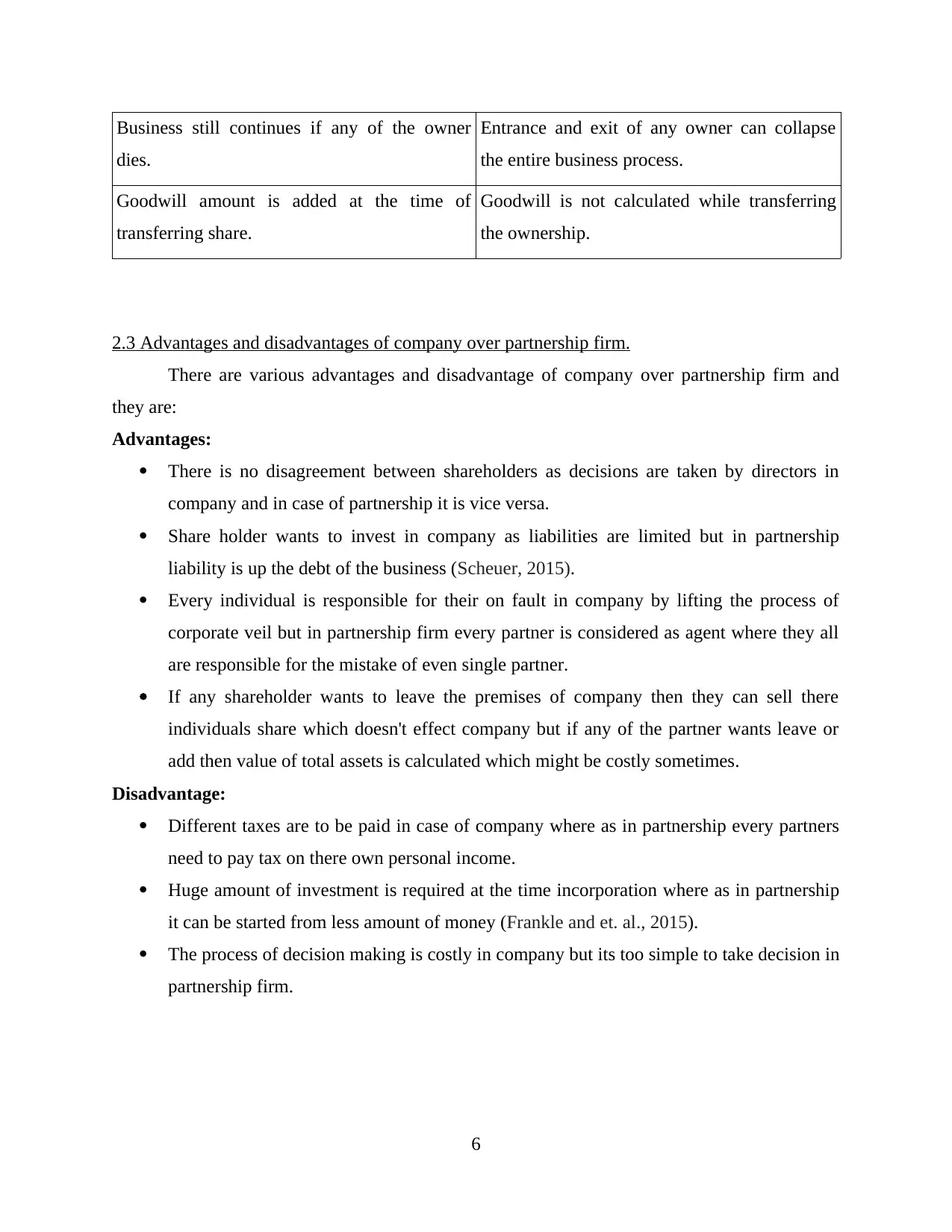
Business still continues if any of the owner
dies.
Entrance and exit of any owner can collapse
the entire business process.
Goodwill amount is added at the time of
transferring share.
Goodwill is not calculated while transferring
the ownership.
2.3 Advantages and disadvantages of company over partnership firm.
There are various advantages and disadvantage of company over partnership firm and
they are:
Advantages:
There is no disagreement between shareholders as decisions are taken by directors in
company and in case of partnership it is vice versa.
Share holder wants to invest in company as liabilities are limited but in partnership
liability is up the debt of the business (Scheuer, 2015).
Every individual is responsible for their on fault in company by lifting the process of
corporate veil but in partnership firm every partner is considered as agent where they all
are responsible for the mistake of even single partner.
If any shareholder wants to leave the premises of company then they can sell there
individuals share which doesn't effect company but if any of the partner wants leave or
add then value of total assets is calculated which might be costly sometimes.
Disadvantage:
Different taxes are to be paid in case of company where as in partnership every partners
need to pay tax on there own personal income.
Huge amount of investment is required at the time incorporation where as in partnership
it can be started from less amount of money (Frankle and et. al., 2015).
The process of decision making is costly in company but its too simple to take decision in
partnership firm.
6
dies.
Entrance and exit of any owner can collapse
the entire business process.
Goodwill amount is added at the time of
transferring share.
Goodwill is not calculated while transferring
the ownership.
2.3 Advantages and disadvantages of company over partnership firm.
There are various advantages and disadvantage of company over partnership firm and
they are:
Advantages:
There is no disagreement between shareholders as decisions are taken by directors in
company and in case of partnership it is vice versa.
Share holder wants to invest in company as liabilities are limited but in partnership
liability is up the debt of the business (Scheuer, 2015).
Every individual is responsible for their on fault in company by lifting the process of
corporate veil but in partnership firm every partner is considered as agent where they all
are responsible for the mistake of even single partner.
If any shareholder wants to leave the premises of company then they can sell there
individuals share which doesn't effect company but if any of the partner wants leave or
add then value of total assets is calculated which might be costly sometimes.
Disadvantage:
Different taxes are to be paid in case of company where as in partnership every partners
need to pay tax on there own personal income.
Huge amount of investment is required at the time incorporation where as in partnership
it can be started from less amount of money (Frankle and et. al., 2015).
The process of decision making is costly in company but its too simple to take decision in
partnership firm.
6
⊘ This is a preview!⊘
Do you want full access?
Subscribe today to unlock all pages.

Trusted by 1+ million students worldwide
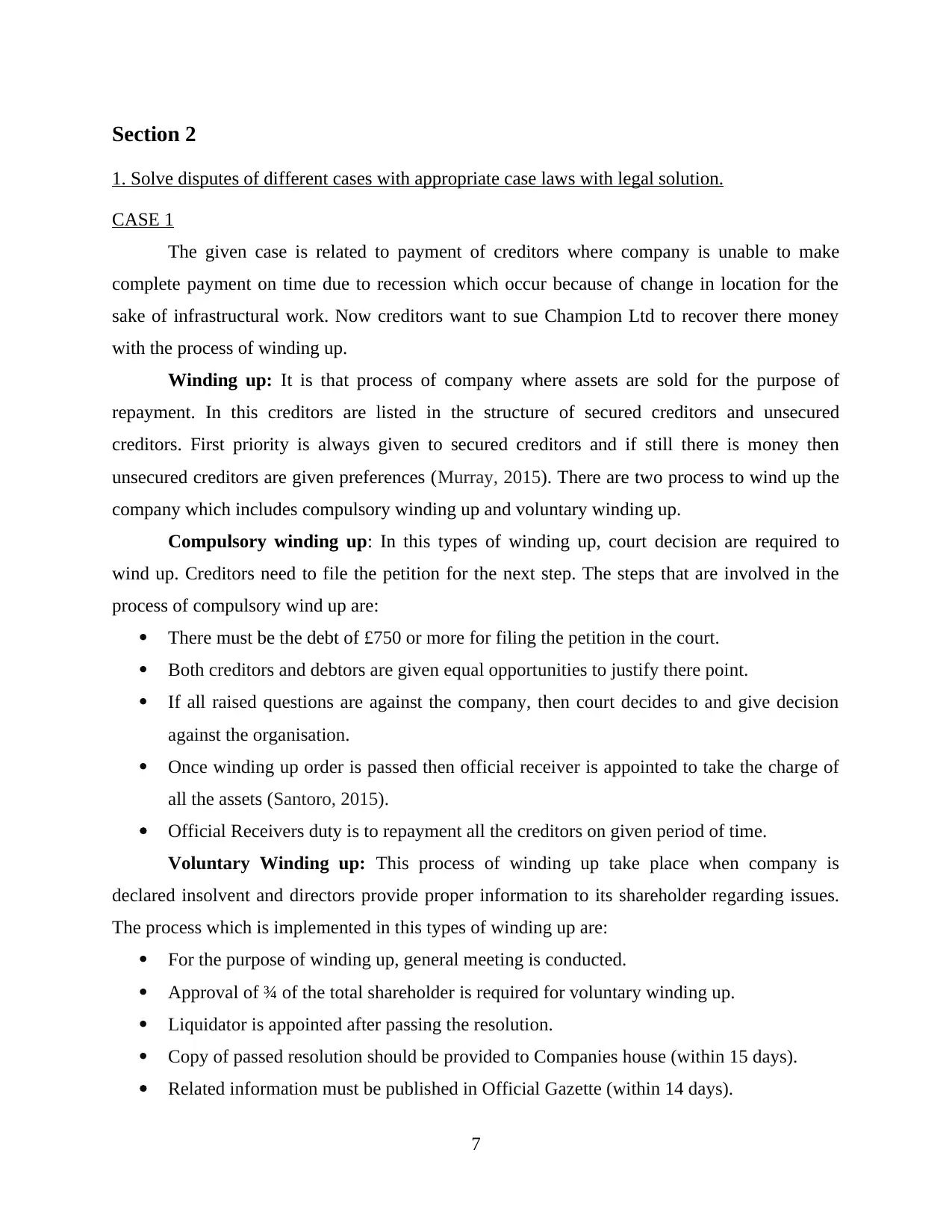
Section 2
1. Solve disputes of different cases with appropriate case laws with legal solution.
CASE 1
The given case is related to payment of creditors where company is unable to make
complete payment on time due to recession which occur because of change in location for the
sake of infrastructural work. Now creditors want to sue Champion Ltd to recover there money
with the process of winding up.
Winding up: It is that process of company where assets are sold for the purpose of
repayment. In this creditors are listed in the structure of secured creditors and unsecured
creditors. First priority is always given to secured creditors and if still there is money then
unsecured creditors are given preferences (Murray, 2015). There are two process to wind up the
company which includes compulsory winding up and voluntary winding up.
Compulsory winding up: In this types of winding up, court decision are required to
wind up. Creditors need to file the petition for the next step. The steps that are involved in the
process of compulsory wind up are:
There must be the debt of £750 or more for filing the petition in the court.
Both creditors and debtors are given equal opportunities to justify there point.
If all raised questions are against the company, then court decides to and give decision
against the organisation.
Once winding up order is passed then official receiver is appointed to take the charge of
all the assets (Santoro, 2015).
Official Receivers duty is to repayment all the creditors on given period of time.
Voluntary Winding up: This process of winding up take place when company is
declared insolvent and directors provide proper information to its shareholder regarding issues.
The process which is implemented in this types of winding up are:
For the purpose of winding up, general meeting is conducted.
Approval of ¾ of the total shareholder is required for voluntary winding up.
Liquidator is appointed after passing the resolution.
Copy of passed resolution should be provided to Companies house (within 15 days).
Related information must be published in Official Gazette (within 14 days).
7
1. Solve disputes of different cases with appropriate case laws with legal solution.
CASE 1
The given case is related to payment of creditors where company is unable to make
complete payment on time due to recession which occur because of change in location for the
sake of infrastructural work. Now creditors want to sue Champion Ltd to recover there money
with the process of winding up.
Winding up: It is that process of company where assets are sold for the purpose of
repayment. In this creditors are listed in the structure of secured creditors and unsecured
creditors. First priority is always given to secured creditors and if still there is money then
unsecured creditors are given preferences (Murray, 2015). There are two process to wind up the
company which includes compulsory winding up and voluntary winding up.
Compulsory winding up: In this types of winding up, court decision are required to
wind up. Creditors need to file the petition for the next step. The steps that are involved in the
process of compulsory wind up are:
There must be the debt of £750 or more for filing the petition in the court.
Both creditors and debtors are given equal opportunities to justify there point.
If all raised questions are against the company, then court decides to and give decision
against the organisation.
Once winding up order is passed then official receiver is appointed to take the charge of
all the assets (Santoro, 2015).
Official Receivers duty is to repayment all the creditors on given period of time.
Voluntary Winding up: This process of winding up take place when company is
declared insolvent and directors provide proper information to its shareholder regarding issues.
The process which is implemented in this types of winding up are:
For the purpose of winding up, general meeting is conducted.
Approval of ¾ of the total shareholder is required for voluntary winding up.
Liquidator is appointed after passing the resolution.
Copy of passed resolution should be provided to Companies house (within 15 days).
Related information must be published in Official Gazette (within 14 days).
7
Paraphrase This Document
Need a fresh take? Get an instant paraphrase of this document with our AI Paraphraser
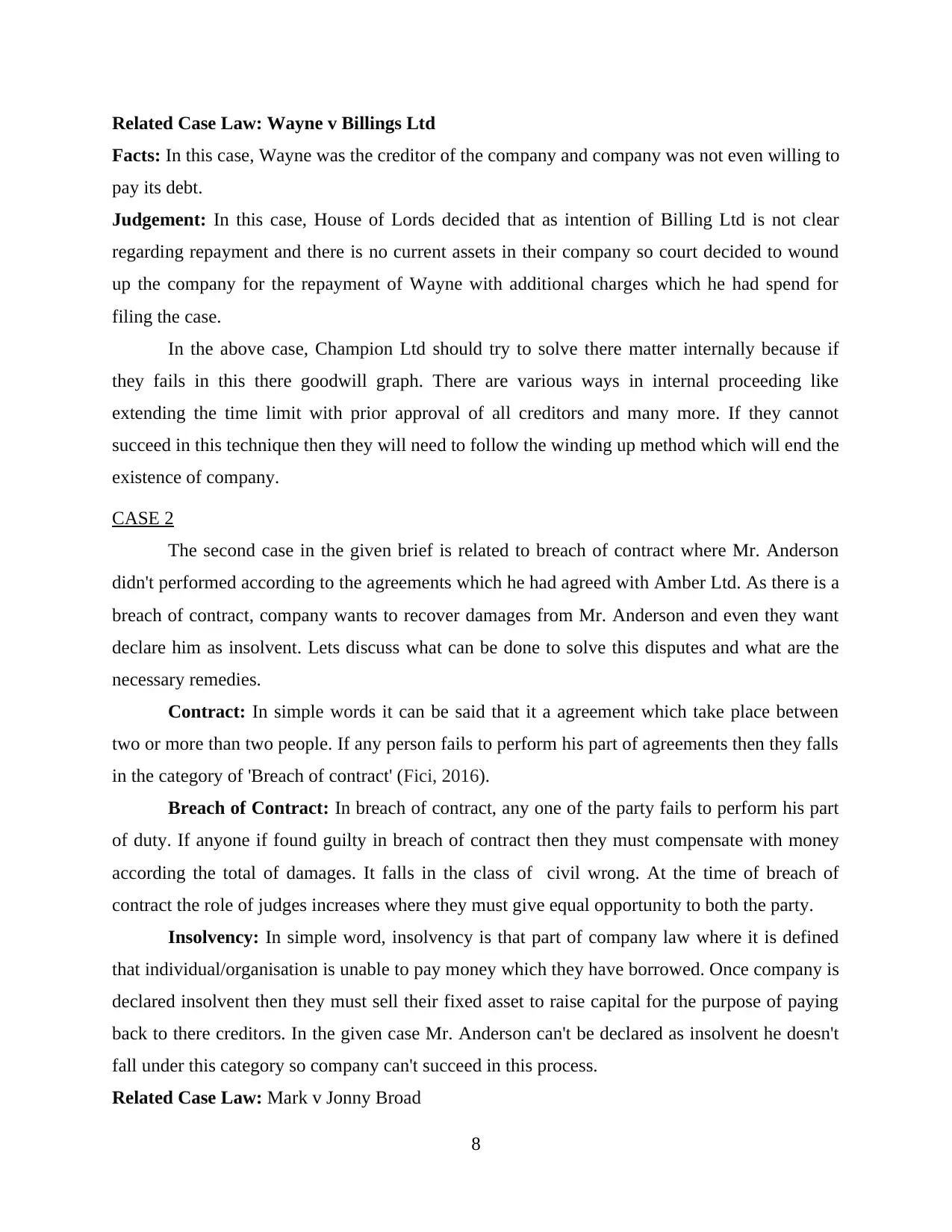
Related Case Law: Wayne v Billings Ltd
Facts: In this case, Wayne was the creditor of the company and company was not even willing to
pay its debt.
Judgement: In this case, House of Lords decided that as intention of Billing Ltd is not clear
regarding repayment and there is no current assets in their company so court decided to wound
up the company for the repayment of Wayne with additional charges which he had spend for
filing the case.
In the above case, Champion Ltd should try to solve there matter internally because if
they fails in this there goodwill graph. There are various ways in internal proceeding like
extending the time limit with prior approval of all creditors and many more. If they cannot
succeed in this technique then they will need to follow the winding up method which will end the
existence of company.
CASE 2
The second case in the given brief is related to breach of contract where Mr. Anderson
didn't performed according to the agreements which he had agreed with Amber Ltd. As there is a
breach of contract, company wants to recover damages from Mr. Anderson and even they want
declare him as insolvent. Lets discuss what can be done to solve this disputes and what are the
necessary remedies.
Contract: In simple words it can be said that it a agreement which take place between
two or more than two people. If any person fails to perform his part of agreements then they falls
in the category of 'Breach of contract' (Fici, 2016).
Breach of Contract: In breach of contract, any one of the party fails to perform his part
of duty. If anyone if found guilty in breach of contract then they must compensate with money
according the total of damages. It falls in the class of civil wrong. At the time of breach of
contract the role of judges increases where they must give equal opportunity to both the party.
Insolvency: In simple word, insolvency is that part of company law where it is defined
that individual/organisation is unable to pay money which they have borrowed. Once company is
declared insolvent then they must sell their fixed asset to raise capital for the purpose of paying
back to there creditors. In the given case Mr. Anderson can't be declared as insolvent he doesn't
fall under this category so company can't succeed in this process.
Related Case Law: Mark v Jonny Broad
8
Facts: In this case, Wayne was the creditor of the company and company was not even willing to
pay its debt.
Judgement: In this case, House of Lords decided that as intention of Billing Ltd is not clear
regarding repayment and there is no current assets in their company so court decided to wound
up the company for the repayment of Wayne with additional charges which he had spend for
filing the case.
In the above case, Champion Ltd should try to solve there matter internally because if
they fails in this there goodwill graph. There are various ways in internal proceeding like
extending the time limit with prior approval of all creditors and many more. If they cannot
succeed in this technique then they will need to follow the winding up method which will end the
existence of company.
CASE 2
The second case in the given brief is related to breach of contract where Mr. Anderson
didn't performed according to the agreements which he had agreed with Amber Ltd. As there is a
breach of contract, company wants to recover damages from Mr. Anderson and even they want
declare him as insolvent. Lets discuss what can be done to solve this disputes and what are the
necessary remedies.
Contract: In simple words it can be said that it a agreement which take place between
two or more than two people. If any person fails to perform his part of agreements then they falls
in the category of 'Breach of contract' (Fici, 2016).
Breach of Contract: In breach of contract, any one of the party fails to perform his part
of duty. If anyone if found guilty in breach of contract then they must compensate with money
according the total of damages. It falls in the class of civil wrong. At the time of breach of
contract the role of judges increases where they must give equal opportunity to both the party.
Insolvency: In simple word, insolvency is that part of company law where it is defined
that individual/organisation is unable to pay money which they have borrowed. Once company is
declared insolvent then they must sell their fixed asset to raise capital for the purpose of paying
back to there creditors. In the given case Mr. Anderson can't be declared as insolvent he doesn't
fall under this category so company can't succeed in this process.
Related Case Law: Mark v Jonny Broad
8
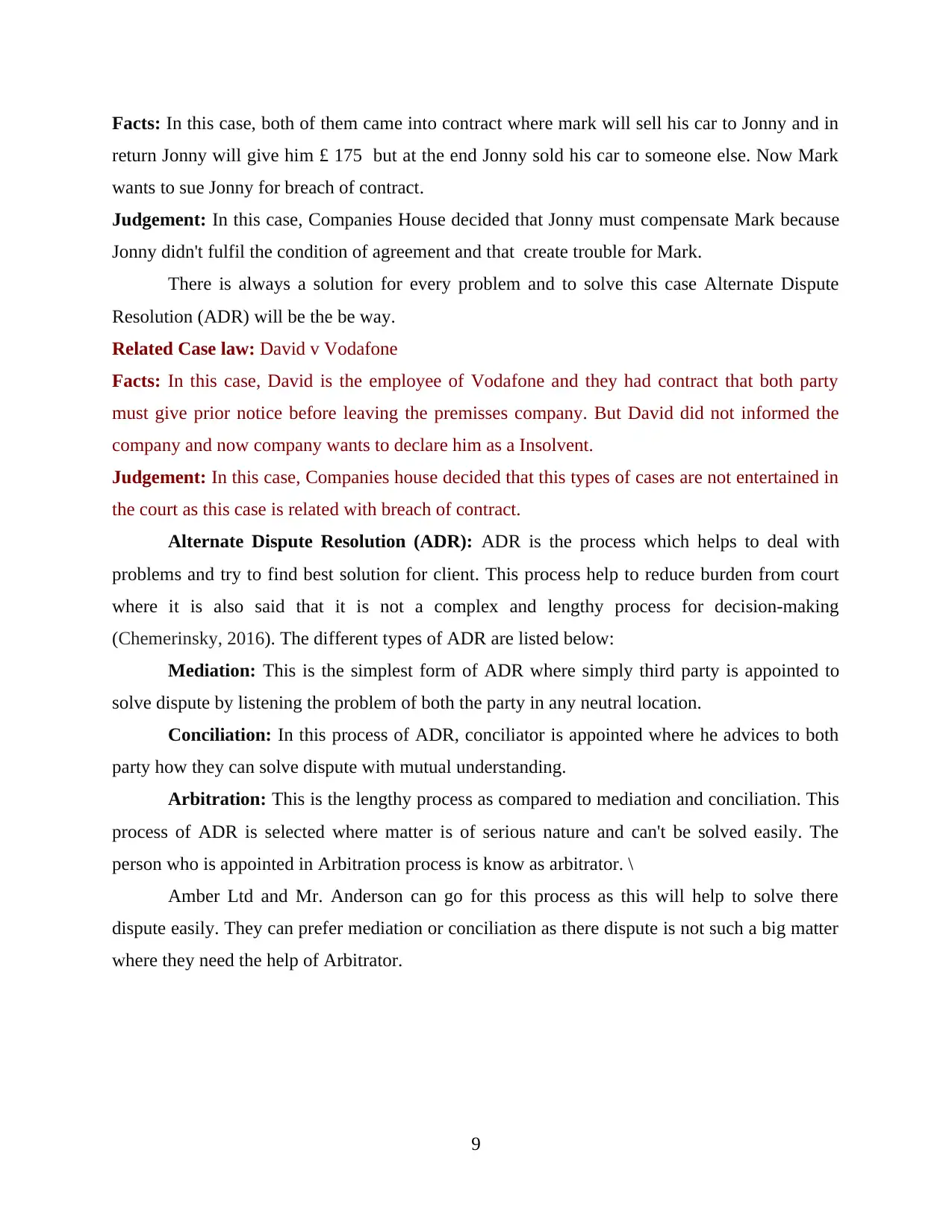
Facts: In this case, both of them came into contract where mark will sell his car to Jonny and in
return Jonny will give him £ 175 but at the end Jonny sold his car to someone else. Now Mark
wants to sue Jonny for breach of contract.
Judgement: In this case, Companies House decided that Jonny must compensate Mark because
Jonny didn't fulfil the condition of agreement and that create trouble for Mark.
There is always a solution for every problem and to solve this case Alternate Dispute
Resolution (ADR) will be the be way.
Related Case law: David v Vodafone
Facts: In this case, David is the employee of Vodafone and they had contract that both party
must give prior notice before leaving the premisses company. But David did not informed the
company and now company wants to declare him as a Insolvent.
Judgement: In this case, Companies house decided that this types of cases are not entertained in
the court as this case is related with breach of contract.
Alternate Dispute Resolution (ADR): ADR is the process which helps to deal with
problems and try to find best solution for client. This process help to reduce burden from court
where it is also said that it is not a complex and lengthy process for decision-making
(Chemerinsky, 2016). The different types of ADR are listed below:
Mediation: This is the simplest form of ADR where simply third party is appointed to
solve dispute by listening the problem of both the party in any neutral location.
Conciliation: In this process of ADR, conciliator is appointed where he advices to both
party how they can solve dispute with mutual understanding.
Arbitration: This is the lengthy process as compared to mediation and conciliation. This
process of ADR is selected where matter is of serious nature and can't be solved easily. The
person who is appointed in Arbitration process is know as arbitrator. \
Amber Ltd and Mr. Anderson can go for this process as this will help to solve there
dispute easily. They can prefer mediation or conciliation as there dispute is not such a big matter
where they need the help of Arbitrator.
9
return Jonny will give him £ 175 but at the end Jonny sold his car to someone else. Now Mark
wants to sue Jonny for breach of contract.
Judgement: In this case, Companies House decided that Jonny must compensate Mark because
Jonny didn't fulfil the condition of agreement and that create trouble for Mark.
There is always a solution for every problem and to solve this case Alternate Dispute
Resolution (ADR) will be the be way.
Related Case law: David v Vodafone
Facts: In this case, David is the employee of Vodafone and they had contract that both party
must give prior notice before leaving the premisses company. But David did not informed the
company and now company wants to declare him as a Insolvent.
Judgement: In this case, Companies house decided that this types of cases are not entertained in
the court as this case is related with breach of contract.
Alternate Dispute Resolution (ADR): ADR is the process which helps to deal with
problems and try to find best solution for client. This process help to reduce burden from court
where it is also said that it is not a complex and lengthy process for decision-making
(Chemerinsky, 2016). The different types of ADR are listed below:
Mediation: This is the simplest form of ADR where simply third party is appointed to
solve dispute by listening the problem of both the party in any neutral location.
Conciliation: In this process of ADR, conciliator is appointed where he advices to both
party how they can solve dispute with mutual understanding.
Arbitration: This is the lengthy process as compared to mediation and conciliation. This
process of ADR is selected where matter is of serious nature and can't be solved easily. The
person who is appointed in Arbitration process is know as arbitrator. \
Amber Ltd and Mr. Anderson can go for this process as this will help to solve there
dispute easily. They can prefer mediation or conciliation as there dispute is not such a big matter
where they need the help of Arbitrator.
9
⊘ This is a preview!⊘
Do you want full access?
Subscribe today to unlock all pages.

Trusted by 1+ million students worldwide
1 out of 14
Related Documents
Your All-in-One AI-Powered Toolkit for Academic Success.
+13062052269
info@desklib.com
Available 24*7 on WhatsApp / Email
![[object Object]](/_next/static/media/star-bottom.7253800d.svg)
Unlock your academic potential
Copyright © 2020–2025 A2Z Services. All Rights Reserved. Developed and managed by ZUCOL.





